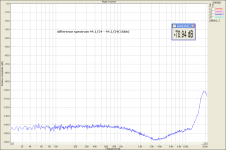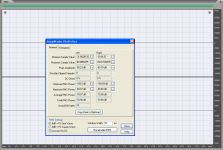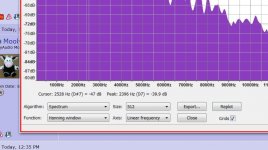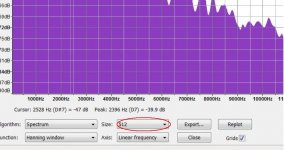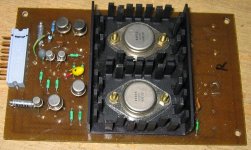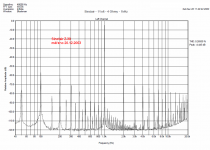Mmm. Looks like you just ABXed noise at -100dB.
Doesn't surprise me.
The noise is higher. The noise is not only narrow band spectral density number, it is an integral over audio band.
Attachments
Last edited:
Good!! 😀
(Mooly, try to enlarge "size") of your FFT (bottom left click box))
🙂 Not following you on that one. Enlarged, now what 😀
Attachments
🙂 Not following you on that one. Enlarged, now what 😀
This. Enlarge "Size" to 16384 or something like that.
Attachments
Gotcha 🙂 Will do next time.
('ve been playing with Audacity this morning to see how it handled displaying channel separation spectrum on a preamp at 1 and 10kHz. Found a new toy 😀)
('ve been playing with Audacity this morning to see how it handled displaying channel separation spectrum on a preamp at 1 and 10kHz. Found a new toy 😀)
Is the pilot tone filter faulty or missing?
Looked at the circuit and it doesn't seem to have one. Certainly no inductive filter elements anywhere on the output. Its 1978 vintage, very "old school" but sounds fantastic.
Sony ST-515 / Tuners & Tube Tuners - Sony / Vintage Audio
WE did not care much in the seventies, though it was a great hobby 😀😀
Absolutely. No foobars and do-dahs, just 2N3055's and plenty of bias 😀 I was trying to think what amplifier it was used with back then. Pretty sure it was a Practical Wireless "Europa" with bizarre LTP input, one side was a darlington (BC109C's ) and the speakers were a three way Peerless design 10" bass, ?? mid and Audax ? soft dome tweeter.
Harmonic distortion of single tone is limiting case of underlying intermodulation mechanism. All sum and difference components are harmonics, or DC.
Correct simulation of distortion to broadband stimulus is much tougher to do and verify against distortion behavior in real systems.
.............
Windows is very naughty; I do all work with XP SP2.
My favorite sound card is E-MU 0404 USB. It has very good performance. Used with ASIO drivers, and software with support, behavior is bit perfect.
My favorite SW for signal generation and analysis is Cool Edit Pro, predating ASIO and has no support.
I can set E-MU clock to 44.1kHz and do loop measurements with Cool Edit, and always get corrupt results.
Output is perfectly well behaved; I capture output with Fostex FR2, and look at results of sound card output using 44.1kHz. FR2 may be set to 44.1kHz, 48kHz, 88.2kHz, etc., and results from E-MU analog output look great when FR2 files are analyzed.
Windows is butchering input from soundcard when it is set to 44.1kHz, but not for other sample rates. What gives? I hate conspiracy, paranoid, and irrational thinking; but it seems to me that Windows went out of the way to hinder early efforts to corrupt analog rip of CD content. This problem existed in Windows 95/NT and persists long after SW for extracting WAV directly from CD became wide spread. My 2 cents.
Correct simulation of distortion to broadband stimulus is much tougher to do and verify against distortion behavior in real systems.
.............
But again, without measurements and analysis one is lost. My card is clocked for 48kHz/96kHz. For 44.1kHz it uses inner sample rate converter (which performs horribly). Thus, i MUST use SW SRC for playback and I do use this in foobar. Please compare what I get from 44.1kHz with and without SRC. The 1kHz test signal is 16 bit, properly dithered.
Windows is very naughty; I do all work with XP SP2.
My favorite sound card is E-MU 0404 USB. It has very good performance. Used with ASIO drivers, and software with support, behavior is bit perfect.
My favorite SW for signal generation and analysis is Cool Edit Pro, predating ASIO and has no support.
I can set E-MU clock to 44.1kHz and do loop measurements with Cool Edit, and always get corrupt results.
Output is perfectly well behaved; I capture output with Fostex FR2, and look at results of sound card output using 44.1kHz. FR2 may be set to 44.1kHz, 48kHz, 88.2kHz, etc., and results from E-MU analog output look great when FR2 files are analyzed.
Windows is butchering input from soundcard when it is set to 44.1kHz, but not for other sample rates. What gives? I hate conspiracy, paranoid, and irrational thinking; but it seems to me that Windows went out of the way to hinder early efforts to corrupt analog rip of CD content. This problem existed in Windows 95/NT and persists long after SW for extracting WAV directly from CD became wide spread. My 2 cents.
I was trying to think what amplifier it was used with back then.
I had copied and slightly modified the The SINCLAIR PROJECT 60 power stage those days 😀
And you, as you claimed a better performance for 24 bit, need to participate to.
No pressure, eh? 🙂
Windows is very naughty; I do all work with XP SP2.
Me too. The displayed result is an external card problem. It has a crystal oscillator only for 48kHz multiples. For 44.1, it uses simple on-board sample rate converter. So it is much better to feed the card with 48/24 or 96/24.
No pressure, eh? 🙂
I have participated, so there is neither problem nor excuses 😀
I had copied and slightly modified the The SINCLAIR PROJECT 60 power stage those days 😀
And that was just the start of the adventure 😀
Last edited:
My family had very similar pair matching SONY tuner and tape deck - maybe even the same ones. Don't remember the digital display on the tuner though. The rest seems familiar. Tape deck controls very familiar. Tuner we had had integrated amplifier I think. Remember it sounding perfectly OK but also remember being completely blown away by a demo of quad electrostatic speakers at the same time so it must have been pretty bad by comparison.
ASIO is a must for serious work on Windows. You can't rely on the usual audio systems (MME and DirectSound) not to mangle your signals.
ASIO is very useful; but not a must. Work must include verification of system performance. In case of Windows for my setup, recording at 44.1kHz is only issue without ASIO.
- Status
- Not open for further replies.
- Home
- General Interest
- Everything Else
- Based on sonics... which do you prefer ?
